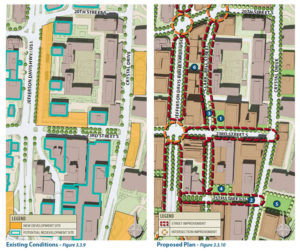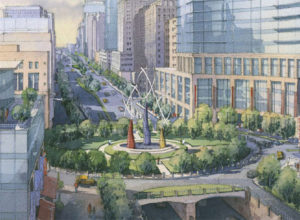 Just before the unanimous vote that would approve a sweeping plan to redevelop Crystal City, county board chairman Jay Fisette paused for reflection. Looking back at the four and a half year process of crafting the plan, Fisette remarked that it “an amazing moment and a startling success.”
Just before the unanimous vote that would approve a sweeping plan to redevelop Crystal City, county board chairman Jay Fisette paused for reflection. Looking back at the four and a half year process of crafting the plan, Fisette remarked that it “an amazing moment and a startling success.”
Then, with five “ayes,” the board set in motion a 40-year development process that will transform the dated, hodgepodge apartments and office buildings in Crystal City into a gleaming, high-density, pedestrian-friendly urban district.
Initially conceived as a response to Crystal City’s impending loss of thousands of jobs as a result of BRAC, the Crystal City Sector Plan is meant to ensure a bright future for the oft-maligned but economically-crucial neighborhood. On numerous occasions last night, speakers pointed out that Crystal City currently produces the lion’s share of commercial tax revenues for Arlington County.
Among other alterations, the plan calls for the creation of a streetcar line, significant changes to the street grid, and an additional 15 million square feet of mixed use development through 2050.
 Although some speakers compared last night’s vote to the 1970s-era growth plan that laid the groundwork for the now-vibrant Rosslyn-Ballston Metro corridor, others spoke of the hardships the Crystal City plan might inflict on surrounding neighborhoods.
Although some speakers compared last night’s vote to the 1970s-era growth plan that laid the groundwork for the now-vibrant Rosslyn-Ballston Metro corridor, others spoke of the hardships the Crystal City plan might inflict on surrounding neighborhoods.
Too much density, not enough open space and an increase in traffic through neighborhood streets were the most-repeated charges. Others complained that the plan did not provide enough of a transition from high-rise development to the single-family neighborhood.
Largely, those complaints were addressed by the final version of the plan, which included a traffic monitoring mechanism, a citizen advisory board, and a mandate to study ways to smooth the transition at the edge of development. The Aurora Highlands Civic Association unsuccessfully argued for a delay in the vote so those last-minute changes could be further reviewed by residents.
Several residents worried that increased density will mean a larger population in Crystal City, which in turn would strain infrastructure, like the already-crowded local schools. Another resident suggested that South Arlington may need its own hospital after a large enough increase in population.
But while acknowledging that the plan wasn’t perfect, representatives from Vornado/Charles E. Smith, the largest private landholder in Crystal City, argued for its passage.
“This plan is the epitome of smart growth,” said company vice president Mitch Bonanno. “There is no smarter place for density in the region, no better time for replacement of older buildings given BRAC, and there is no better sponsorship to make it happen than Crystal City property owners and Arlington.”
In the end, the board sided with the forces of change.
“We should feel great about this one,” Fisette said after the vote.
“I’m very proud of this document,” echoed board member Barbara Favola. “It’s a good plan.”

